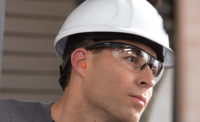Noise-induced hearing loss (NIHL) is the most common permanent and preventable occupational injury impacting workers today. And unlike most injuries it is painless, progressive, permanent and preventable. An obvious cause of NIHL is continuous, long-term exposure to sounds at or exceeding 85 decibels, but even a single exposure to high-decibel impulse noise can cause lasting damage. The duration of workers’ exposure to noise and their proximity to the source are key factors in the effect noise has on an individual’s hearing.
The toll of occupational noise exposure on workers is significant and includes temporary and permanent hearing loss or tinnitus (ringing in the ears), limited ability to understand speech, impaired ability to communicate, reduced productivity, social isolation and withdrawal, and increased risk of hypertension and high cholesterol. The cost to employers is also sizable: according to the OSHA, U.S. businesses paid more than $1.5 million in penalties last year for not protecting workers from noise. Finally, the burden to society is substantial: OSHA estimates $242 million is spent on workers’ compensation for hearing loss disability each year.
Noise hazards are prevalent across industries: food and beverage processing, manufacturing, construction, utilities, oil and gas, and many more. OSHA’s regulation 29 CFR 1910.95 calls for hearing protection to be provided wherever noise averages more than 85 dB during an eight-hour day. Yet despite this guidance, of the 22 million workers exposed to hazardous noise levels at work each year, 34% report not wearing hearing protection and at least eight million suffer from NIHL.
Among the various types of hearing protection solutions on the market, earplugs are the most commonly used. They are comparatively inexpensive, portable, disposable, and don’t interfere with other types of PPE. But not all earplugs are created equal. This article looks at key considerations among different styles of earplugs to help you better protect your workforce’s invaluable, lifelong sense of hearing.
Roll-down earplugs
Roll-downs are single-use, disposable earplugs. Made of foam, they are very pliable and generally allow users to achieve good control over their fit, pressure and feel. Roll-downs come in a wide variety of shapes, sizes and firmness and are an economic solution, especially for temporary and part-time workforces. And because they’re disposable, there’s no maintenance required: at the end of a shift, users simply throw away their roll-downs and start with a new pair the next day.
Roll-down earplugs also present unique challenges. The first is the possibility of carrying dirt and grime into the ear canal. Rolling down the earplug material before insertion requires dexterity — and when a worker’s fingers are dirty, dusty, grimy or greasy, that soil can transfer onto the foam and makes its way into the ear canal. Roll-downs must be placed far enough into the ear so the user is protected from hazardous noise. It can take some getting used to the feeling of embedding a roll-down deeply into the ear canal for a sealable fit, but those who leave a portion of their earplug outside the canal are likely to get less protection or no protection from hazardous noise.
Finally, because they’re not reusable, roll-downs generate waste. For companies with an eye toward conservation-based practices, the waste generated by disposable earplugs — including the packaging as well as the earplugs — may be a deterrent.
Reusable earplugs
Reusable earplugs last between two and four weeks, allowing employers to not only reduce waste but also oftentimes save money since workers use fewer pairs per week. Made of plastic, they come in various shapes designed for smooth and easy insertion and a solid fit, eliminating the need to wiggle or burrow them into the canal. Innovative designs allow body heat to help the earplug adapt to the shape of the ear; block hazardous noise while allowing voices through; and even eliminate the common plugged-up feeling. Triple- and quadruple-flange styles help adjust size, shape and pressure inside the canal for the ultimate personalized fit. And because no roll-down is required, reusables can offer a more hygienic solution than disposables.
Reusable earplugs are good for environments where workers can retain and store earplugs for future use. They’re also ideal where noise is intermittent: corded styles are common and allow for easy removal and replacement. Finally, they’re easily cleaned with soap and water; no chemicals required.
For individuals sensitive to plastic, reusable earplugs may not be compatible. Likewise, those who prefer the feel of foam may not achieve a comfortable fit from plastic styles. Re-useable earplugs generally provide less attenuation than a well-fit foam earplug.
Push-in foam earplugs
Push-in foam (PIF) earplugs are a hybrid solution that combines the benefits of disposable and reusable styles. PIFs deliver the comfort of foam but with the hygienic benefit of reusable earplugs – no roll-down required. Moderately priced, they can be reused up to five days making them an economical solution for temporary and full-time workers alike.
Push-in foam models feature special innovations that make them a comfortable, reliable solution for a wider segment of the workforce. PIFs with ergonomic stems are easy to fully insert and remove, even while gloves are worn, and eliminate the transfer of dirt from workers’ fingers to the ear. Those with soft dimpled tips collapse, allowing them to be easily and gently pushed into the ear canal. And they’re available corded and uncorded for the convenience of frequent removal and replacement.
Because PIFs are made of foam, which is denser than plastic, they deliver higher attenuation ratings than reusables, making them useful in consistently loud environments. Before selecting any style of high attenuating earplugs, however, be sure to measure noise levels and select the corresponding attenuation to ensure clear, safe communication among workers where needed.
Outfitting workers with effective hearing protection is vital, but because every ear canal is unique no single solution will meet every individual’s need for fit, comfort and protection. By understanding the different types of earplugs available and offering a variety of solutions, employers can help deliver the three Cs of hearing protection — comfort, convenience and compatibility — and workers can return home to their favorite sounds at the end of every shift.



